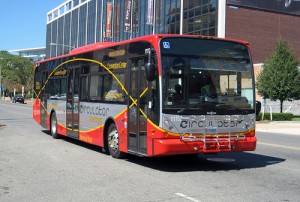I like that they are going to be red.
Now reading about the future of D.C. transit, via “The Case for Streetcars“:
Almost 50 years ago, streetcars in Washington, D.C. stopped running and most of their tracks were removed. Now they’re back and ready for a revival, with parts of the first two lines slated to open next spring. In this post, we talk to Dan Tangherlini, the former DDOT director under Mayor Anthony Williams, who committed to building one of the first two lines, about why streetcars matter for the nation’s capital.
LONG-TERM VISION
The streetcars were conceived in 1997, when Mayor Marion Barry’s Department of Public Works published “A Transportation Vision, Strategy, and Action Plan for the Nation’s Capital.” The plan called for circulator buses and streetcars to connect existing Metrobus and Metrorail lines and activity centers close to the city’s core. Planners think these additional connections are important since current rail lines connect neighborhoods to the city center but not necessarily to each other; this sometimes makes travel between neighborhoods and activity centers on different transit lines difficult, despite the 106 miles of Metrorail track and 319 Metrobus routes that exist today. Plus, as one presentation of the city’s transportation department puts it, overcrowding on Metrorail will be “unmanageable by 2013” and several Metrobus lines are already over capacity.
The first Circulator bus route began operation in 2005. The red buses, with their large windows, 10-minute headways, and easy-to-understand routes connecting bustling neighborhoods, became increasingly popular and today there are six routes near the city’s center. When the streetcar network is complete – sometime after 2016 – it will span 37 miles over eight lines (see map below) and will connect to the Circulator routes. The streetcars will run on above-ground, electric-powered rails; some streetcars will share lanes with traffic while others will run in lanes for streetcars only. Like the Circulator buses, the streetcars will have sleek red exteriors with large windows and doors at curb-height. And they too will connect activity centers both downtown and in city neighborhoods and have headways of 10-15 minutes.






